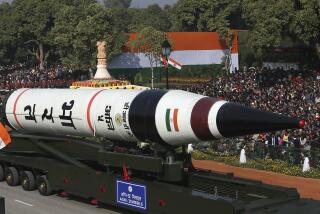U.S. Says New Intermediate-Range Missile to Be Test-Flown by China
- Share via
WASHINGTON — China is expected to flight-test a new intermediate-range ballistic missile this year that ultimately will target Russia and India but not the continental United States, U.S. officials said Friday.
The so-called DF-31, which has been in development for nearly two decades, would be China’s first solid-fueled, truck-mounted missile and the first ballistic missile design Beijing has introduced since the early 1980s.
The missile will carry a single 400-kiloton warhead, which China tested in the mid-1980s, officials said. Recent revelations about Chinese spying at U.S. nuclear weapon laboratories have raised fears that China soon would develop and deploy missiles carrying multiple, independently targeted reentry warheads.
U.S. officials don’t know how many of the DF-31 missiles will be built, but no evidence suggests that the Chinese are speeding up production. Some analysts have said the weapon could be put into service as early as 2003, but one official said similar four-year predictions “have been made every year for the last decade.”
U.S. analysts say the DF-31 will replace the DF-4, which is aimed against Russia and India, and will have a range of about 5,000 miles. That puts Hawaii and Alaska at risk, as well as the U.S. bases in Asia, but the U.S. intelligence community doesn’t consider the DF-31 an anti-U.S. system.
“The idea that it [the DF-31] is a strike force against the United States is just plain wrong,” said an official who has reviewed the intelligence data. “And the idea that it will somehow change the strategic balance, or increase the threat to the U.S. homeland, is dead wrong.”
Intelligence analysts say it is a matter of speculation as to whether China’s new warhead incorporates material acquired from the United States, including secrets stolen from America’s nuclear laboratories.
A classified report by a House investigative committee headed by Rep. Christopher Cox (R-Newport Beach) argues that espionage at two labs in the late 1970s and mid-1980s allowed Beijing to adapt technology from two U.S. warheads, the W-70 and the W-88, to build the new weapon, according to two U.S. officials who have reviewed the report.
Many in the U.S. intelligence community don’t agree. “The theory is it’s a hybrid knockoff that uses parts of W-70 and W-88 technology, but there’s no evidence supporting that,” said one official. “We believe we influenced it, but they didn’t replicate or copy our weapon.”
He noted that similar warheads are used by the four other major nuclear powers, and the concepts behind making nuclear weapons smaller, lighter and more powerful are widely known in scientific circles.
The DF-31 warhead is believed to be one-fifth the weight and have one-tenth the explosive power of the massive warheads China now has atop its strategic nuclear strike force.
China has 18 to 20 intercontinental ballistic missiles capable of hitting the United States. Beijing has no strategic bomber force, and its only nuclear-armed submarine has never successfully test-fired a missile, U.S. officials say.
More to Read
Sign up for Essential California
The most important California stories and recommendations in your inbox every morning.
You may occasionally receive promotional content from the Los Angeles Times.














